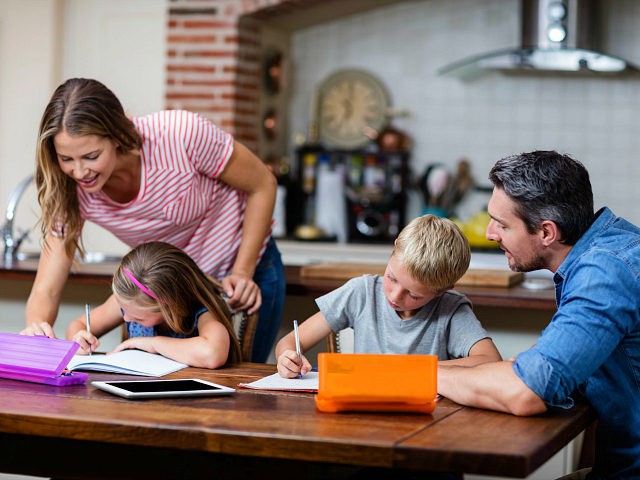Teachers’ unions and other stakeholders in government-run K-12 schools are seeking billions of dollars in funding in a fourth federal coronavirus relief bill.
Though the most recent coronavirus aid bill provided the U.S. Education Department with almost $31 billion in funding, at least a dozen teachers’ unions and government school advocacy organizations are calling for a minimum of another $200 billion in taxpayer funds.
Half of Americans – 163 million people – do not have high-speed internet at home.
And the federal government's nearly $2 trillion stimulus package doesn't address this digital divide, even though nearly all of our country's schools are closed. #COVID19https://t.co/sAuIkITPer
— NEA Education Votes (@edvotes) April 7, 2020
The political action arm of the National Education Association (NEA), the nation’s largest teachers’ union, stated the coronavirus stimulus provided thus far “doesn’t do nearly enough for students and educators—especially in light of school closures, the switch to online instruction, and the intense strain on state budgets we know is coming”:
Now is the time to begin pushing for more funding where we know it is needed: the Education Stabilization Fund to help fill state budget gaps and prevent educator layoffs, closing the “homework gap” experienced by students who don’t have internet devices or access at home, and expanding student loan forgiveness.
We have to make sure workers have the support they need to get out of this economic travesty caused by this pandemic and the federal government's unpreparedness. – @rweingarten to the @PaAFL_CIO https://t.co/M6qmBe5aDU
— AFT (@AFTunion) April 7, 2020
"That the pandemic occurred is not Trump’s fault. The utter unpreparedness of the United States for a pandemic is Trump’s fault." @davidfrum https://t.co/zk922nX0gN
— AFT (@AFTunion) April 8, 2020
Politico reported Wednesday a coalition of groups, including the NEA, the American Federation of Teachers (AFT), the School Superintendents Association, and the National School Boards Association, has written to Congress asserting they need more funding to address school closures and the interrupted school year caused by the coronavirus:
They’re seeking at least $175 billion to help bolster state education budgets, $13 billion for special education, $2 billion in funding to the E-Rate educational technology program, and $12 billion for Title I to help low-income schools, the groups said.
…
The groups said that, as states face drastic revenue declines, Congress must “acknowledge the need for an unprecedented level of investment.”
As we fight #COVID19, it is vital that we pass it before November. #AFTvotes https://t.co/cbPjtHLQL1
— AFT (@AFTunion) April 8, 2020
However, according to data reported in October by the National Assessment of Educational Progress (NAEP), also known as the Nation’s Report Card, U.S. school children have made “no progress” in reading or mathematics over the past decade while actually attending school.
Additionally, while many government school advocacy groups are claiming the distance learning in which most students are now engaged is inequitable because it favors students from middle-class families who have access to the Internet, the Nation’s Report Card showed the disturbing performance of America’s lower income children after being taught in school.
Peggy Carr, associate commissioner of the National Center for Education Statistics (NCES), noted:
Over the past decade, there has been no progress in either mathematics or reading performance, and the lowest-performing students are doing worse. In fact, over the long term in reading, the lowest-performing students—those readers who struggle the most—have made no progress from the first NAEP administration almost 30 years ago.
U.S. Education Secretary Betsy DeVos called the NAEP results “frankly devastating.”
“This country is in a student achievement crisis, and over the past decade it has continued to worsen, especially for our most vulnerable students,” she said, adding:
Two out of three of our nation’s children aren’t proficient readers. In fact, fourth grade reading declined in 17 states and eighth grade reading declined in 31. The gap between the highest and lowest performing students is widening, despite $1 trillion in Federal spending over 40 years designated specifically to help close it.
NCES especially noted the “growing disparities between the highest and lowest achievers” in the decade between 2009 and 2019.
NEW: Over the last 10 years, higher performing students’ scores have increased and lower-performing students’ scores have decreased in math and reading. Read more about the growing gap in our latest blog: https://t.co/SL7gxP2aES#NAEP #edresearch #edpolicy #edchat pic.twitter.com/ywtfvF7uAv
— NAEP (@NAEP_NCES) October 30, 2019
“This must be America’s wake-up call,” DeVos said. “We cannot abide these poor results any longer. We can neither excuse them away nor simply throw more money at the problem.”
5 Anti-Racist Actions for White People to Take During #COVID19 #EdJusticehttps://t.co/yVyYBr29J0
— NEA (@NEAToday) April 3, 2020
According to a Gallup survey released Thursday, more than eight in ten parents now say their child is engaged in remote learning:
In the two weeks that Gallup has been tracking the ways in which U.S. schoolchildren are being educated during the COVID-19 pandemic, the percentage of parents who say their child is learning remotely through a school-sponsored online distance learning program has grown from 65% to 83%.
Only 4 percent of parents, down from 11 percent, now say their child has no instruction at all.

COMMENTS
Please let us know if you're having issues with commenting.